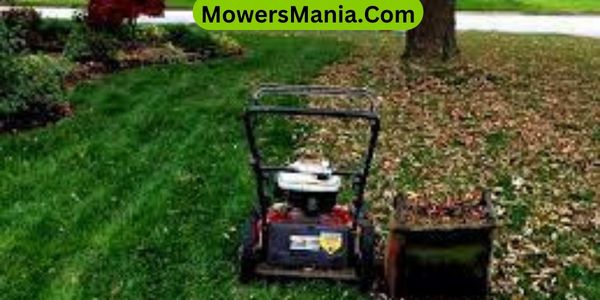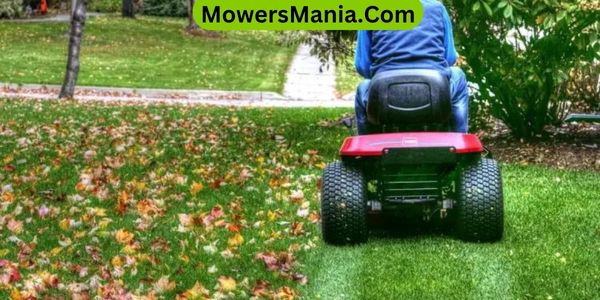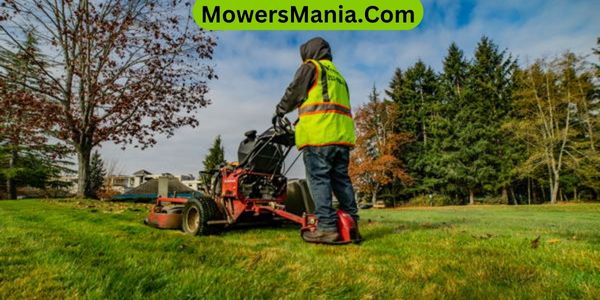If you’re tired of raking leaves, there’s a better way. Using a lawn mower to pick up leaves is efficient and saves time. In this article, you’ll learn how to select the right mower, adjust its height, and use the proper technique for mowing leaves.
You’ll also discover how to handle wet leaves, decide between bagging and mulching, and maintain your lawn after leaf removal. Say goodbye to backbreaking leaf raking and hello to a tidier yard.

Selecting the Right Lawn Mower
When choosing a lawnmower, consider the size of your yard and the type of terrain you’ll be mowing. For smaller yards with relatively flat terrain, a push mower may be sufficient. These mowers are easy to maneuver and ideal for yards under half an acre.
However, if your yard is larger or has uneven terrain, a self-propelled mower might be a better option. These mowers are easier to maneuver on sloped or hilly areas and require less physical exertion.
For even larger yards, a riding mower could be the best choice. These mowers are efficient for yards over an acre and can handle various terrains with ease.
Another factor to consider is the type of grass in your yard. If you have thick, tough grass, a gas-powered mower might be the most effective, providing the necessary power to cut through it.
For smaller, more eco-friendly options, electric mowers are a great choice. They’re quieter, require less maintenance, and produce zero emissions.
Ultimately, selecting the right lawnmower depends on the specific needs of your yard and the features that will make mowing as efficient and effortless as possible.
Adjusting the Mower Height
To achieve the best results when picking leaves with a lawn mower, adjust the mower height to the appropriate setting for your specific grass type and the condition of your lawn.
The height of the mower blade is crucial when it comes to effectively picking up leaves without damaging your grass.
Follow these tips to ensure you set the mower height correctly:
- Consider your grass type: Different grasses thrive at different heights, so it’s important to know the ideal height for your specific grass type. Adjust the mower to a height that promotes a healthy lawn while effectively picking up leaves.
- Assess the condition of your lawn: If your lawn is uneven or has patches of thicker grass, you may need to adjust the mower height to accommodate these variations. This will help ensure an even cut and thorough leaf collection.
- Start with a higher setting: When beginning to pick up leaves, start with a higher mower setting and gradually lower it if necessary. This allows you to gauge the effectiveness of leaf collection without risking damage to your grass.
Mowing Technique for Leaves

You should use a side discharge or mulching mower for the most effective mowing technique when picking up leaves.
A side discharge mower expels the leaves out the side of the mower deck, spreading them across the lawn. This can be helpful if you have a large area to cover and the leaves aren’t too thick.
On the other hand, a mulching mower is designed to finely chop the leaves into small pieces, allowing them to decompose quickly and return nutrients to the soil.
When using a mulching mower, it’s important to mow more frequently as leaving thick layers of leaves on the lawn can smother the grass. Additionally, mow at a slower pace to give the mower blades enough time to chop the leaves finely.
Dealing With Wet Leaves
When dealing with wet leaves, it’s important to prioritize safety. Wet leaves can be slippery and increase the risk of accidents, so make sure to proceed with caution.
Additionally, maintaining your mower is crucial for effectively handling wet leaves. By regularly checking and cleaning the mower’s blades, you can ensure optimal performance and reduce the chances of clogging.
Using the best mowing techniques will also help you achieve the desired results. For instance, raising the mower deck to a higher setting can prevent the mower from getting bogged down in wet foliage. Additionally, mowing in a steady, consistent pattern can help prevent clumps of wet leaves from forming.
Remember to take breaks as needed and stay hydrated during the task. It’s also a good idea to wear appropriate clothing and footwear for better traction and protection.
Wet Leaves Safety Tips
When mowing wet leaves, ensure that your lawn mower blades are sharp to prevent clogging and ensure efficient cutting. Wet leaves can easily clump and stick together, making it essential to have sharp blades for a clean cut.
Additionally, adjust your mowing speed to accommodate the wet leaves. Slower speeds can help prevent clogging and ensure a more even cut.
Moreover, consider using a lawn mower with a higher deck setting to avoid pushing the wet leaves into the ground, which can lead to a messy and uneven cut.
Lastly, always prioritize safety when mowing wet leaves. Be mindful of slippery surfaces and wear appropriate footwear to prevent any accidents.
Mower Maintenance for Wet Leaves
Maintenance for mowing wet leaves involves regularly clearing grass clippings and debris from the mower deck to prevent clogging and ensure optimal performance.
When dealing with wet leaves, it’s crucial to keep the underside of the mower deck clean. After each use, take the time to remove any wet clumps of leaves or grass stuck to the deck. This will prevent buildup and potential clogging during future use.
Additionally, make sure to sharpen the mower blades regularly to ensure they can efficiently cut through wet leaves without strain.
It’s also important to check and replace the air filter if necessary, as wet leaves can cause the filter to clog more quickly.
Best Mowing Techniques
To effectively mow wet leaves, regularly clear the mower deck of any debris and sharpen the blades to ensure optimal performance.
When dealing with wet leaves, consider these techniques:
- Adjust the mowing height to a slightly higher setting to prevent clumping and clogging.
- Mow in overlapping rows to ensure thorough leaf mulching and avoid leaving behind patches of uncut leaves.
- Clean the mower after use to prevent wet leaves from sticking to the underside of the deck, which can hinder future mowing sessions.
Bagging Vs. Mulching Leaves
When it comes to picking leaves with a lawn mower, you might be wondering whether to bag or mulch them.
Mulching leaves offers the benefit of creating nutrient-rich mulch for your lawn and garden. Plus, it reduces waste and saves you time and effort compared to bagging.
Nutrient-Rich Mulch Benefits
For the most nutrient-rich mulch benefits, consider mulching your leaves rather than bagging them. Mulching leaves offers several advantages for your lawn and garden:
- Natural Fertilization: Mulched leaves break down over time, releasing valuable nutrients into the soil, acting as a natural fertilizer for your plants.
- Soil Health: Mulch helps improve soil structure, moisture retention, and overall soil health, creating a better environment for plant growth.
- Cost-Effective: Mulching leaves with a lawn mower is a cost-effective option compared to bagging and disposing of them, saving you time and money while benefiting your yard.
Less Waste With Mulching
When mowing leaves, opt for mulching over bagging for less waste and more benefits for your lawn and garden.
Mulching leaves with your lawn mower allows the shredded leaves to decompose and return valuable nutrients to the soil. This natural mulch acts as a protective layer, retaining moisture and suppressing weed growth.
Unlike bagging, mulching leaves eliminates the need for disposal and reduces the volume of waste. It also saves time and effort by eliminating the task of bagging and disposing of the leaves.
Additionally, the nutrient-rich mulch created by mulching the leaves provides a sustainable and eco-friendly way to nourish your lawn and garden.
Lawn Maintenance After Leaf Removal

How do you ensure proper lawn maintenance after removing leaves with a lawn mower?
Once you’ve cleared the leaves with your lawn mower, it’s important to follow through with proper lawn maintenance to keep your yard in top shape.
Here are a few essential tips to help you maintain a healthy lawn after leaf removal:
- Fertilize: After removing the leaves, consider fertilizing your lawn to replenish essential nutrients that may have been depleted during the leaf removal process. This will promote healthy growth and help your lawn recover from the fall season.
- Aerate: Aerating your lawn can help improve air, water, and nutrient penetration, which is crucial for maintaining a healthy root system. Consider aerating your lawn after leaf removal to ensure that your grass can thrive.
- Overseed: If the leaf removal process has left any bare patches on your lawn, overseeding can help fill in those areas and promote a lush, even lawn. Choose a grass seed that’s suitable for your specific climate and soil type.
Frequently Asked Questions (FAQs)
Can I Use a Regular Lawn Mower to Pick up Leaves, or Do I Need a Specific Type of Mower?
You can use a regular lawn mower to pick up leaves by attaching a bagger or mulching kit. Make sure the mower has enough power and a wide deck to effectively collect and mulch the leaves.
Will Using a Lawn Mower to Pick up Leaves Damage My Lawn in Any Way?
Using a lawn mower to pick up leaves won’t damage your lawn if done properly. Just make sure the mower is set to the right height and the leaves aren’t too thick. It can actually benefit your lawn.
Are There Any Safety Precautions I Should Take When Using a Lawn Mower to Pick up Leaves?
When using a lawn mower to pick up leaves, remember to wear closed-toe shoes, and clear the area of any debris. Check the lawn for hidden obstacles or sticks that could damage the mower.
Can I Use a Leaf Blower or Rake in Combination With a Lawn Mower to Pick up Leaves More Effectively?
You can use a leaf blower or rake in combination with a lawn mower to pick up leaves more effectively. It helps to gather the leaves into smaller piles first for easier pickup.
How Often Should I Mow Over the Leaves to Ensure They Are Picked up Efficiently?
Mow over the leaves multiple times in different directions to ensure they are picked up efficiently. The more times you mow, the more likely the leaves will be chopped up and collected by the lawn mower.
Conclusion
So, the next time you need to pick up leaves with your lawn mower, make sure you have the right mower for the job and adjust the height to the appropriate level.
Remember to use a mowing technique that ensures the leaves are properly mulched or bagged. If the leaves are wet, take extra precautions and consider bagging them instead of mulching.
After the leaves are gone, don’t forget to give your lawn some extra care to maintain its health.
Happy mowing!



